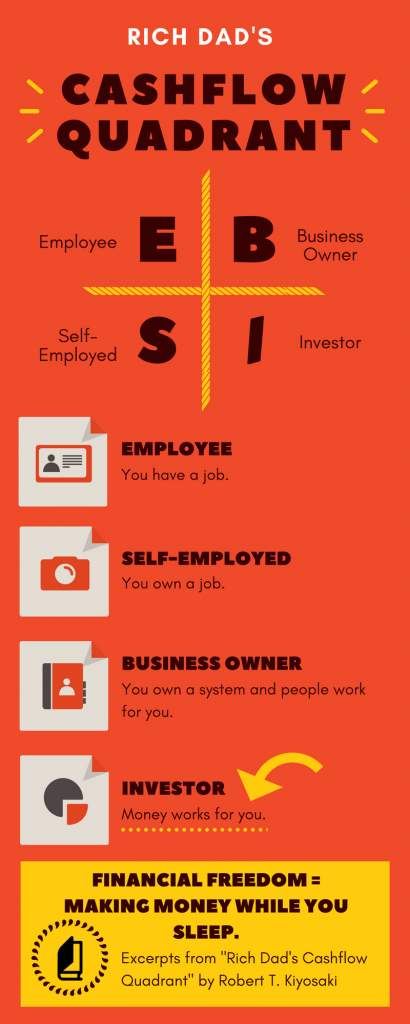The Cashflow Quadrant could make you a millionaire. But how do you turn a formula on a page into dollars in the bank? We’ll explore that in today’s article.
The information in Robert T. Kiyosaki’s book, “Rich Dad’s Cashflow Quadrant” is a follow-up to his best-seller, “Rich Dad, Poor Dad.” Kiyosaki used this formula in his own life, enabling him to become so wealthy that he never needs to work again in his life.
The ultimate definition of “financial freedom.”
However, is this concept your one shot at getting rich? Is it effective? Here is my honest review of “Rich Dad’s Cashflow Quadrant.”
Rich Dad’s Cashflow Quadrant – Is It Your Guide to Financial Freedom?
First of all, you can’t approach this information without understanding who “Rich Dad” is.
Who is Rich Dad?
Robert T. Kiyosaki is an inventor, educator, adviser, investor, and author of the popular financial book, “Rich Dad, Poor Dad.” The basic concept of this bestseller is that Kiyosaki was highly influenced by two dads: His real father who was highly educated but took very little risks in business, and his friend’s father who thought outside the box regarding money and was very wealthy.
“Rich Dad” taught Kiyosaki to find ways to make money while he slept. He encouraged him to rethink “successful.” He taught him about growing businesses, establishing professional networks and relationships, and not settling for a nine-to-five life when investing could make him richer with more time for family.
“Poor Dad” encouraged Kiyosaki to go to college, find a stable job, and settle down. Poor Dad ultimately took bad advice from brokers and financial advisors who recommended he buy a bigger house when his income increased to ease the tax burden. When Poor Dad’s job vanished and most of his future employment prospects with it, he spent the rest of his life under stress and the burden of debt.
Now, let’s take a look at how Rich Dad made his wealth and how it applies to you.
What is the Cashflow Quadrant?
According to Kiyosaki, “The Cashflow Quadrant is about the four different types of people who make up the world of business, who they are and what makes individuals in each quadrant unique.”
For example, in the infographic below, you’ll see the following quadrants:
- Employee – You work for someone. (i.e. teacher, nurse, legal assistant)
- Self-Employed – You work for yourself. (i.e. plumber, photographer, web designer)
- Business Owner – People work for you. (i.e. restaurant franchise owner, landscaping company)
- Investor – Money works for you. (i.e. Investing money in your friend’s business, buying properties)
How is the Cashflow Quadrant going to help you get rich?
Studying this concept will challenge your thinking in many ways. Being an “E” or an “S” is very normal in our society. Kiyosaki’s goal is to convince you to strive toward the right side of the chart. He wants to challenge your preconceived notions on earning money. Sure, you may be more predisposed to be an employee rather than a business owner, but you’ll never know until you dig into this material and find out.
If you transition to the right side of the chart, you can become very wealthy through investing.
Then why aren’t more people investing?
Risk. Kiyosaki acknowledges the greater risks in quadrants “B” and “I,” but this is his response:
“People who take risks change the world.”
What are the drawbacks?
If you’re going to consider grabbing a copy of “Rich Dad’s Cashflow Quadrant,” my review of his book would not be complete without including the drawbacks.
- The book has a great deal of redundancies, cliches, and dry storytelling. Be ye warned. The concepts are sound. Life-changing, even. However, if Kiyosaki would have weeded out the excess, his book would have been a third of its length.
- Get ready for a lot of homework. I believe it’s great to research the Cashflow Quadrant and see how it applies to your life, but there are some very complex concepts that Kiyosaki encourages readers to research in order to succeed in the “B” and “I” arenas. Dave Ramsey once said to never place your money in something you don’t fully understand. If you plan to pursue a business venture or invest in real estate, you absolutely must do the research on these ideas.
Final Thoughts
“Rich Dad’s Cashflow Quadrant” will give you the following short-term and long-term benefits:
Short-Term: It will open your eyes to new ways of viewing money. You’ll understand where you currently fall on the spectrum and what practical steps you can take to start your transition toward greater wealth-building.
Long-Term: These steps applied over time will produce greater wealth. You can create more time for your family, less financial stress, and fewer penalties in taxes.
In which quadrant do you currently reside?
This post may contain affiliate links.


